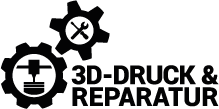HOW TO MATRIX
The hurdle in 3d repair is often the CAD design. In order to provide a contact point for the topic of 3d repair, the German Association of Open Workshops (VOW) has set up a public communication channel („room“) on a Matrix server* (*what exactly is Matrix, see below).
This should be the place where repairers and people with CAD knowledge can meet online. Repairers can place requests for CAD design of spare parts and volunteer CAD-designers can take care of the cases. Also information about 3d printing the model like suitable printing techniques, settings and materials can be discussed.
This channel is part of the project "Reparieren verbindet" (Repairing Connects), which had the goal of networking repairers and makers more closely.
1. Create an account
To join the Matrix channel („room“) it is necessary to choose a Matrix client. There are a number of clients, we recommend "Elements", which comes from the Matrix developers.
https://app.element.io/#/register
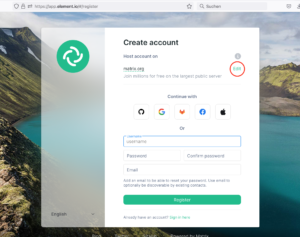
The language can be changed at the bottom left.
If you don´t want to use the browser you can download the Elements App.
1a. Select homeserver
To use Matrix you need to choose a homeserver where your files like messages are stored.
Here you can select the standard Matrix server (default) or select another server you trust (Edit).
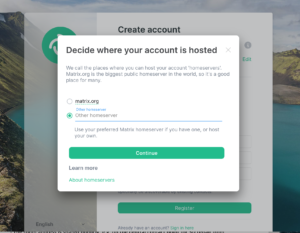
1b. Create username and password
Type in a username, a password and mail adress. You will recieve a mail to validate your mail address. You can also use existing accounts e.g. from GitHub.

2. Join the room
Under this link you can join the communication room:
https://matrix.to/#/#3drepair:vow.chat
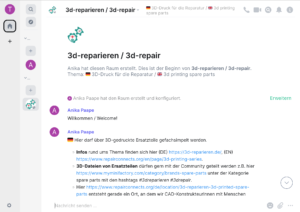
At the moment, mainly German volunteers have joined the room. However, English is understood by most and is not a problem.
The room address can be shared publicly, e.g. on the central contact point for 3D repair from the Sharepair project or on national repair sites. Then, for example, representatives from repair cafés who need help modelling a spare part and tips for printing can set up an account and present their case. Private repairers can also set up an account, join and post a request. Once a helper has been found, further communication can continue in a private chat, e.g. also via video chat. We would be pleased if the results, e.g. photos of the printed spare part with an indication of the printing process, printer settings and material, could be found again in the room as documentation.
Notifications for the room can be activated.
3. Bridging
It is possible to set up a bridge to other channels of e.g. Discord, Telegram, Signal, Slack, FB Messenger or WhatsApp, which can synchronise the communication between chats to these channels. We are checking whether there are already channels of these services that are suitable for this in terms of content (topic: 3D printing spare parts). If you know of such channels in your countries, please feel free to share them with us.
* Matrix is a decentralised open source protocol for communication. Besides group communication, a 1:1 chat with voice messages and video call function is possible. End-to-end encryption is possible. However, since the room created by VOW is to be publicly usable, communication there is not encrypted.
Communication via Matrix is comparable to e-mail traffic, so the Matrix room is a kind of mailing list and the homeserver is like a mail provider. You can join the same room coming from different servers. (see youtube video „Matrix for beginners“)
THAT'S WHY
The mountain of e-waste is growing from year to year (23 kg/German capita/year (source: statista.com, 2016)), also because suitable spare parts are not available for many devices or they are difficult to obtain or available at disproportionately high prices. With the help of 3D printing, however, it is possible to contribute to independent commercial and private repair by producing simple spare parts at affordable prices. Mostly, these are functional parts such as knobs, hooks, gears or individual housing parts made of plastic.
The Runder Tisch Reparatur network is campaigning for comprehensive spare parts availability, and the Right to repair alliance at international level.
HOW DOES 3D-PRINTING FOR REPAIR WORK?
We press the switch quickly and with our thoughts completely elsewhere. But instead of starting the toaster, turning on the light or turning off the kettle like thousands of times before, the switch breaks. And although the appliance is actually still perfectly fine, we can no longer operate it. A penny item is often responsible for the disposal of an appliance that is in itself fully functional. What used to be a typical case for repair is now increasingly ending up on the annually growing mountain of electronic waste. And this is not least because suitable spare parts are not available for many appliances or are difficult to access.
We are pursuing the goal of making better use of the sustainability potential of 3D printing and creating a networking structure in which spare parts can be produced at affordable prices and installed in otherwise still functional old devices. We want to bring together people with 3D printing know-how from, for example, Makerspaces and FabLabs with initiators of Repair Cafés and repair businesses.
We want to work together to identify hurdles and best practices and develop measures that strengthen 3D printing for spare parts production. In this way, we want to promote the re-use and re-purposing of equipment and save resources that would otherwise be needed for the production of new equipment.
WHO WE ARE
We are two industrial designers with a focus on sustainable conception and product design who initiated the project "Strengthening reuse through repair - using the potential of 3D printing for spare parts procurement" for the Sustainable Design Center e.V. and carried it out from mid-2017 to spring 2019. After the project ended, we continued to pursue the topic of repair using 3D printing and are now active in the projects described below. If you have any questions or suggestions, please do not hesitate to contact us. You can reach us at:
Astrid Lorenzen astrid@3d-reparieren.de Hamburg
Anika Paape anika@3d-reparieren.de Köln
SHAREPAIR
In the EU Interreg project SHAREPAIR, we are working for the Prototypes for Europe association with the partner organisations TU Delft and the University of Manchester, among others, to make as many high-quality 3D files as possible available to a broad public of repairers as a basis for 3D printing of spare parts. To this end, we are collecting our own files and want to launch a multilingual metasearch. In addition, a generator is to be developed in cooperation with our associated partner dap (Digital Additive Productions) at RWTH Aachen University, which is to generate the required spare parts in different variants.
COMPLETED PROJECT
The materials provided on this page were created as part of the project "Strengthening reuse through repair - using the potential of 3D printing for spare parts procurement". The project was funded by the German Federal Environment Agency and carried out by the Sustainable Design Center e.V.. The materials are freely available for download under the Creative Commons Attribution 4.0 International Licence (CC BY 4.0) and should enable many repairers to get started with the topic.
The aim of the project was to use the sustainability potentials of additive manufacturing processes, i.e. 3D printing, to promote the re-use and re-purposing of everyday devices and thus save resources that would be needed for the production of new devices.
People with know-how about 3D printing technology, who are mainly found in Makerspaces and Fab Labs, were brought together with initiators of Repair Cafés and repair businesses in networking workshops. In the process, hurdles for 3D repair, but also best practices could be identified.
The idea of networking was continued in the project REPARIEREN VERBINDET of the association of open workshops in 2020.
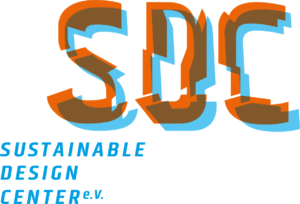


Dieses Projekt wurde gefördert durch das Umweltbundesamt und das Bundesministeriums für Umwelt, Naturschutz, Bau und Reaktorsicherheit. Die Mittelbereitstellung erfolgte auf Beschluss des Deutschen Bundestages.
